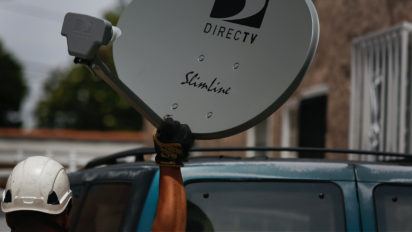Service subject to DIRECTV terms and conditions (see https://www.directv.com/legal/legal-policy-center). Available only in the U.S. (excludes Puerto Rico and U.S.V.I.). Some offers may not be available through all channels and in select areas. Different offers may apply for eligible multi-dwelling units. Early termination fees apply for a maximum of $480, prorated at $20 per month over the 24-month term. Visit directv.com/legal or call for details.
Regional Sports & Local Channels: Regional Sports available with CHOICE and above. Not available in select areas. Channels vary by package & billing region. Device may need to be in billing region in order to view. Limits: Programming subject to blackout restrictions.
All offers, packages, programming, promotions, features, terms, restrictions & conditions and all prices and fees not included in price guarantee are subject to change or discontinuation without notice.
DIRECTV Svc Terms: Subject to Customer Agreement & Equipment Lease (equipment lease not available in select sales channels for DIRECTV via Internet). Taxes, surcharges, add-on programming (including premium channels), DIRECTV Protection Plan, DIRECTV Tech Protect, transactional fees, and Federal Cost Recovery Fee are not included in two-year price guarantee. Visit directv.com/legal/ or call for details.
VIA SATELLITE:
Pricing: ENTERTAINMENT $84.99/mo., CHOICE $115.98/mo., ULTIMATE $145.98/mo., PREMIER $190.98/mo. for 2 years. After 2 years, continues month to month at then-current prevailing prices unless canceled. Prices reflect base package prices plus the req’d. $15/mo. Advanced Receiver Service Fee and Regional Sports Fee (RSF) of up to $15.99/mo. RSF applies to CHOICE Pkg or higher and varies based on location. May be lower in some areas. Additional Taxes & Fees: $7/mo. for each additional TV connection on your account. Applicable use tax expense surcharge on retail value of installation, custom installation charges, equipment upgrades/add-ons, and certain other add’l fees & charges. See directv.com/directv-fees/ for additional information. $10/mo. Autopay and Paperless Bill Discount: Must enroll in autopay & paperless bill within 30 days of TV activation to receive bill credit starting in 1-3 bill cycles (pay $10 more/mo. until discount begins). Must maintain autopay/paperless bill and valid email address to continue credits. Equipment Non-Return-Fees: If you cancel your service, you must return your leased equipment. Failure to return any equipment will result in fees of $45 for each standard DIRECTV Receiver, each HD DIRECTV Receiver, each Genie Mini and each Gemini receiver and $135 for each DVR, HD DVR, Genie® HD DVR and/or Genie 2 DIRECTV Receiver.
Gemini Device: For optimal performance, you will need a continuous Internet connection, your use of which is subject to the fees, restrictions, terms, and limitations imposed by your Internet service provider.
VIA INTERNET: Requires high speed internet. Minimum internet speed of 8Mbps per stream recommended for optimal viewing. Pricing: ENTERTAINMENT $84.99/mo., CHOICE $115.98/mo., ULTIMATE $145.98/mo., PREMIER $190.98/mo. for 2 years. After 2 years, continues month to month at then-current prevailing prices unless canceled. Prices reflect base package prices plus the req’d. $15/mo. Advanced Receiver Service Fee and Regional Sports Fee (RSF) of up to $15.99/mo. RSF applies to CHOICE Pkg or higher and varies based on location. May be lower in some areas. Additional Taxes & Fees: $7/mo. lease fee for each additional TV on your accountand certain other add’l fees & charges may apply. State and local taxes or other governmental fees and charges may apply including any such taxes, fees or charges assessed against discounted fees or service credits. See directv.com/directv-fees/ for additional information. Equipment Non-Return-Fees: If service is cancelled you must return included and leased device to avoid a non-return fee of $120 per device. If you cancel your service within the first 14 days of ordering, a full refund of charges will be applied, and the early termination fees will be waived. If service is canceled after 14 days, you can continue to access DIRECTV through the end of the bill period, but there is no refund or credit for partial-month or unwatched content.


![How to program and reset your DIRECTV remote]() How to program and reset your DIRECTV remote Robin Layton — 5 min read
How to program and reset your DIRECTV remote Robin Layton — 5 min read![Does bundling internet, TV and phone services make sense for you? Sales pros chime in!]() Does bundling internet, TV and phone services make sense for you? Sales pros chime in! Lisa Iscrupe — 3 min read
Does bundling internet, TV and phone services make sense for you? Sales pros chime in! Lisa Iscrupe — 3 min read![DIRECTV’s future in doubt as AT&T hints that it might stop selling the service outside of rural areas]() DIRECTV’s future in doubt as AT&T hints that it might stop selling the service outside of rural areas Joe Supan — 4 min read
DIRECTV’s future in doubt as AT&T hints that it might stop selling the service outside of rural areas Joe Supan — 4 min read



